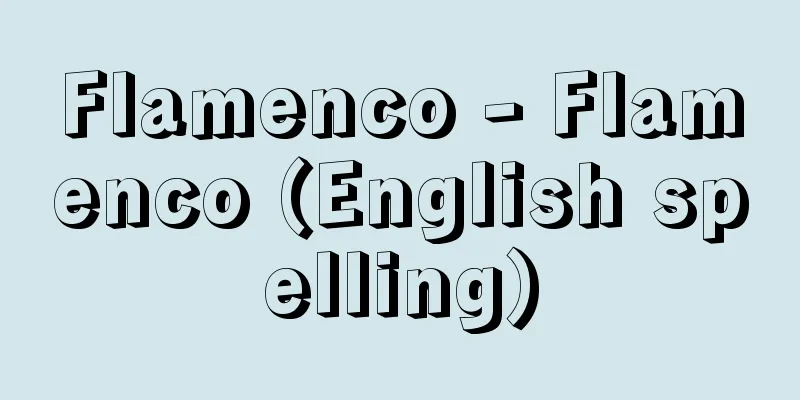Flamenco - Flamenco (English spelling)

|
It is a form of folk dance and music from the Andalusian region in southern Spain. It was developed and passed down mainly by the Roma (formerly known as Gypsies) of the southern part of the region. The foundations of modern flamenco were established in the 18th century, when the Roma settled in the region. Flamenco consists of the dance baile flamenco, the song cante flamenco, and the guitar solo toque. Originally, it was performed by one dancer (or a pair of men and women), one singer, and one guitar player, but in recent years, various performance styles have been seen. The various kinds of flamenco songs can be conveniently classified into the following five types based on their characteristics: (1) Jondo or grande songs, with profound and serious content (polo, soleares, siguirilla, etc.). (2) Lively, light-hearted singing, mostly accompanied by dancing (alegrias, bulerías, fandanguillas, etc.). (3) Intermedio songs, which are somewhere between the two above (tiento, malagueña, petenera, etc.). (4) Cantaores (singers) who have added Andalusian folk songs other than flamenco to their repertoire (milonga, vito, tanguillo, villancico, etc.). (5) Saeta, which has a strong religious character. There are also forms that combine the two genres, such as soleares for bulerías. [Alvarez Jose] "The History of Flamenco" by Shigeru Hamada (1983, Shobunsha) [Reference] |A musical dance from the Andalusian region of southern Spain. The dance itself is musical, with elements such as pitos (finger clapping), palmas (hand clapping), and zapateado (foot stomping). Seville, Spain ©Shogakukan "> flamenco Source: Shogakukan Encyclopedia Nipponica About Encyclopedia Nipponica Information | Legend |
|
スペイン南部のアンダルシア地方の民俗舞踊と音楽の一形態。おもに同地方南部のロマ(かつてはジプシーとよばれた)により発展、継承されてきた。今日的なフラメンコの基礎が固められたのは、ロマの同地方定住がいちおう完了した18世紀のことである。 フラメンコは、舞踊のバイレ・フラメンコbaile f.と歌謡のカンテ・フラメンコcante f.、ギター・ソロのトケtoqueからなる。本来は、踊り手1人(または男女1組)、歌い手1人、ギター奏者1人で演奏されたが、近年ではさまざまな演奏形態がみられる。 カンテ・フラメンコの多くの曲種を、その性格から便宜的に分類すると次の5種になる。 (1)深遠で重い内容のカンテ・ホンドまたはカンテ・グランデ(ポロ、ソレアレス、シギリーリャなど)。 (2)陽気で軽快、大半が踊りを伴うカンテ・チコ(アレグリアス、ブレリアス、ファンダンギーリャなど)。 (3)上の二つの中間的存在であるカンテ・インテルメディオ(ティエント、マラゲーニャ、ペテネラなど)。 (4)カンタオール(歌い手)がフラメンコ以外のアンダルシア民謡などを自己のレパートリーに加えたもの(ミロンガ、ビト、タンギーリョ、ビリャンシーコなど)。 (5)宗教性の強いサエタ。このほかに、ソレアレス・ポル・ブレリアスなどのように、二つの曲種を結合した形式もある。 [アルバレス・ホセ] 『浜田滋郎著『フラメンコの歴史』(1983・晶文社)』 [参照項目] |スペイン南部、アンダルシア地方の音楽舞踊。ピトス(指打ち)、パルマス(手拍子)、サパテアド(足踏み)など、踊り自体が音楽性を備えている。スペイン セビーリャ©Shogakukan"> フラメンコ 出典 小学館 日本大百科全書(ニッポニカ)日本大百科全書(ニッポニカ)について 情報 | 凡例 |
<<: Playa - English spelling playa Spanish
Recommend
Nuclear fusion
Nuclear fusion is a nuclear reaction that creates...
Sesmaria (English spelling)
Agricultural and pastoral land during the colonial...
Bibionidae; March fly
A general term for insects belonging to the Dipter...
Warty newt
A species of salamander (illustration) whose males...
Geissler tube
A cold cathode discharge tube with a vacuum level...
glochid
…The subfamily Opuntia consists of 7 genera and 4...
co-ordinates
…The suit style began to be seen in women's c...
The Lord of the Rings
A full-length novel written by Tolkien, a British...
Yoshino Shrine
An ancient villa located along the Yoshino River....
Sallinen, T.
…Eero Järnefelt (1863-1937) was also a lyrical la...
Company-initiated severance pay - kaishatsugoutaishokukin
…Even before the employment labor system was born...
Oyodo [town] - Oyodo
A town in Yoshino County, central Nara Prefecture....
Ikegami ruins
...It is also worth noting that full-scale salt p...
Sulfinyl chloride
...Common name for sulfinyl chloride. Chemical fo...
Nuidono Ryo - Nuidono Ryo
A ritsuryo government office under the Ministry of...









